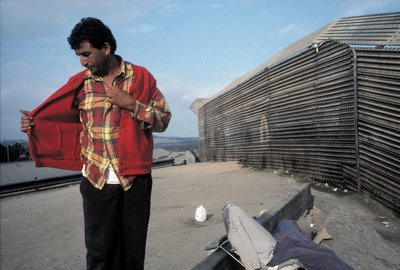Border CTRL

Wonder how the the so-called military-industrial-complex envisions the future of patrolling illegal immigration? "Picture an intruder stepping stealthily across an international borderline. Now shift to a U.S. Command and Control center several miles away where a computer system is alerting a security officer to the intruder's movement, having detected the slight sound of a footstep and zeroed in on the intruder's exact location. The security officer dispatches a UAV to monitor from the air, ground forces to intercept on the ground, and the intruder is stopped."
Global Border Patrol, easy as apple pie. Well, not exactly.

Despite overwhelming protests from all sorts of critics, border communities, immigration policy advocates, foreign governments, humanitarian and environmental groups, and roughly half the American population, the House of Representatives overwhelmingly pushed forward a proposal recently to build a 700 mile border fence between the U.S. and Mexico.

Designed to prevent an incursion of terrorists in the form of illegal border-crossers, the U.S., as we read, would build "a double set of steel walls with floodlights, surveillance cameras and motion detectors (that) run along five segments of the 1,952-mile border" stretching across California, Arizona, New Mexico, and Texas. Not entirely dissimilar from the Israeli Security Wall carving up the West Bank, the construction would go right through precious estuaries and wetlands, would cut off small farms and local businesses from the cross-border commerce they have depended on for years, and would likely prove a multi-billion dollar boondoggle for the Dept. of Homeland of Security.

[Image: Some facts about the construction, according to Tyche Hendricks in the San Francisco Chronicle, 2006]
While Northrop Grumman Corp. competes for a $2.5-billion contract to build a high-tech border surveillance infrastructure, GCS Research is busy developing the commercial applications of a recently declassified military program, the Blue Rose: a "next-generation covert intelligence and surveillance sensor system" which can be used "to detect, track, classify, notify, and communicate information about moving objects in remote locations." It's an acoustic-based awareness technology designed by the Navy (NUWC), and for one the U.S. government just happens to think the borderlands would make the perfect testing grounds. For an intense historical account of the gradual militarization of the U.S./Mexico border, check out this article. And then, don't forget to throw Sandia's Generic Model for Cooperative Border Security into the mix, or this plan to expand domestic wiretapping in Texas.

Without rambling forever on this topic, there's far more at stake here than just issues of security. I wonder, how is turning over responsibility and control of our border management, our immigration policy, and ultimately, the debate over our own domestic labor practice, to the military going to solve anything? How does converting the border into a fortress sublime, or some kind of experiment in landscape militarism and surveillance gentrification, going to help create jobs in either the U.S. or Mexico? Isn't the mass exodus of illegal border-crossers into the U.S. more a reflection of an ultimately imbalanced international economy than an issue of border control?
Here's a little Q&A with Homeland Security Over U.S.-Mexico Border Woes (New York Times)
[Photographs were taken by Alex Webb, Crossings: Photographs from the U.S.-Mexican border.]







0 Comments:
Post a Comment
<< Home